Reluctant Televangelists: Worship in the Bible Belt during the Pandemic
A look into how churches in North Carolina have transformed because of COVID-19
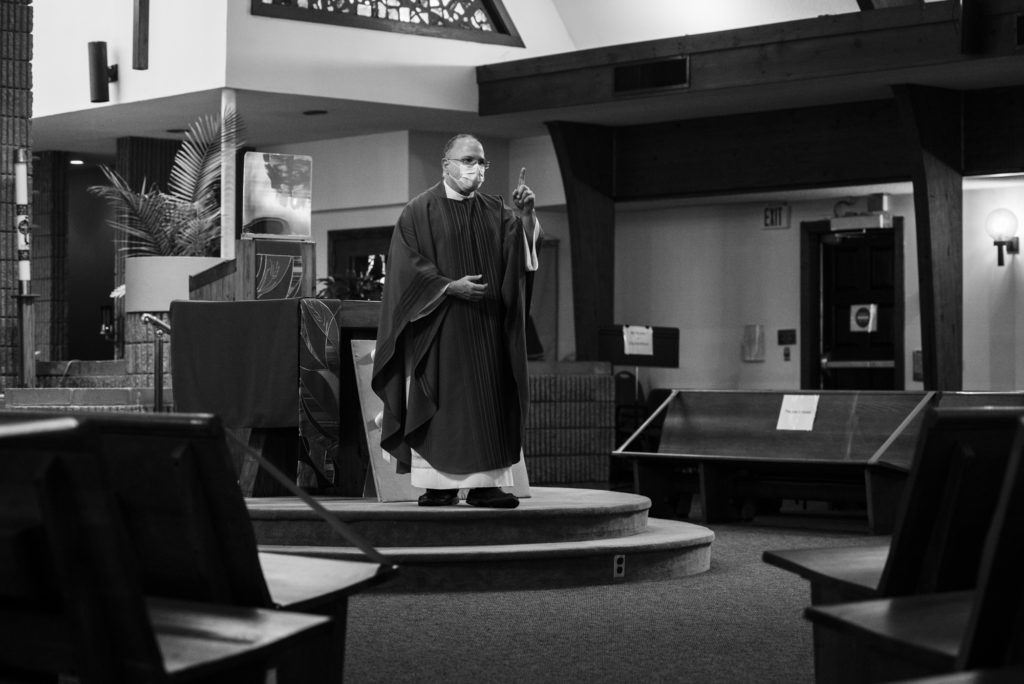
Father Robert Rutledge leads a Saturday evening mass at Church of the Holy Infant on August 1, 2020 in Durham, North Carolina. (Photo: Pete Kiehart)
With every verse and refrain, Bryan Dougan’s voice becomes more urgent. “We are so weary of this coronavirus and so hungry for the physical community of Holy Family. Feed our desperate hungers with your divine mercy and grace. Bread of the world, hear our prayer.” Despite the intention in his timbre, his prayers echo hollowly in the cavernous nave; its pews sit empty. A member of Church of the Holy Family in Chapel Hill, North Carolina, Dougan is one of the congregants who helps create Sunday’s weekly video service, a necessity of the pandemic given the dangers of mass gatherings.
“We’re basically producing a TV show,” observes Reverend Clarke French, who says the process has been the steepest learning curve of his twenty years in the clergy. “I had to learn five new software platforms since the pandemic started.”
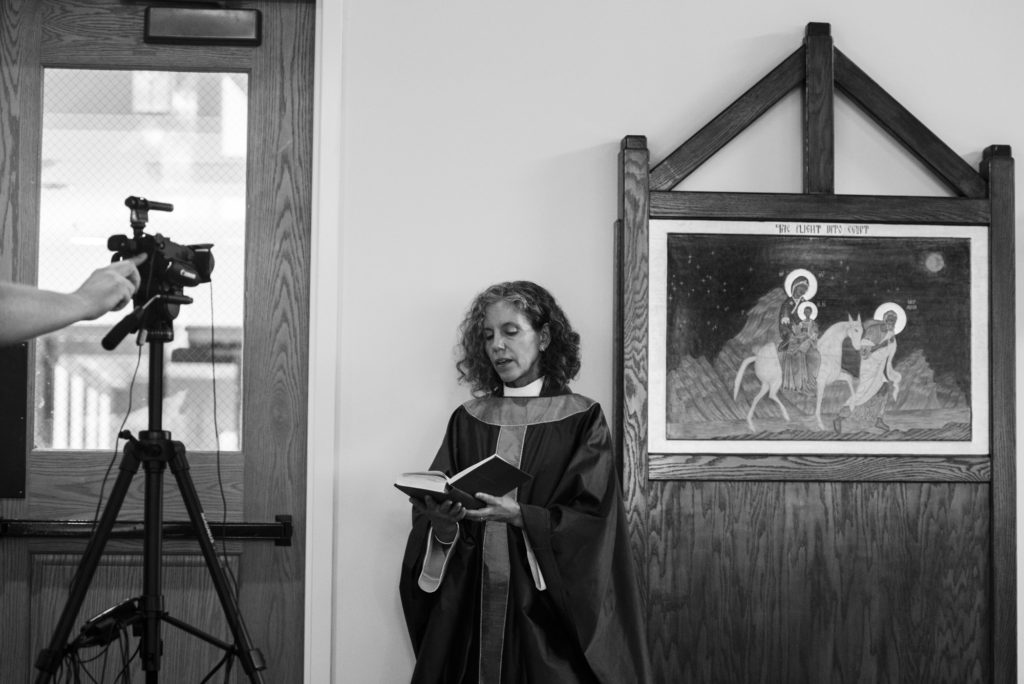
Associate Pastor Sarah Ball-Damberg, assisted by Pastor Clarke French, left, prepares to record a portion of the following Sunday’s service at Church of the Holy Family on July 29, 2020 in Chapel Hill, North Carolina. (Photo: Pete Kiehart)
Although the services, which Reverend French uploads to YouTube, become available every Saturday night, he encourages his congregation to maintain their habits by watching them on Sunday mornings. The efforts are crucial, he says, to stem the post-pandemic crash in attendance that he and his colleagues at other churches fear. “We’re all expecting to come back a quarter smaller,” he sighs. “We’re all reluctant televangelists.”
***
North Carolina boasts the third-highest number of Christian congregations in the United States, according to the U.S. Religion Census. Only Texas and California, both of which dwarf North Carolina in population and geographic area, have more churches. With a deep influence on the state’s culture, urban ministries punctuate North Carolina’s cities, and chapels of every size appear on country roads, themselves often named after churches.
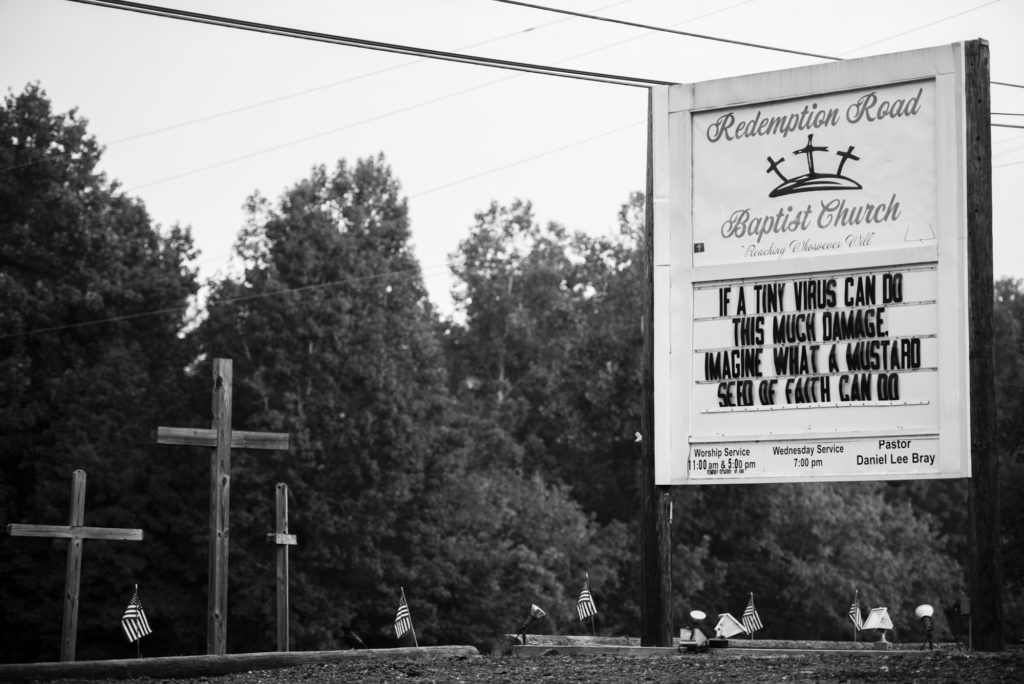
A sign displays a message related to the pandemic in front of Redemption Road Baptist Church on August 28, 2020 in Reidsville, North Carolina. (Photo: Pete Kiehart)
In March, two days after the state reported its first COVID-19 death, North Carolina Governor Roy Cooper issued an executive stay-at-home order that banned gatherings of more than ten people — essentially outlawing in-person religious services. A May order that moved the state to ‘Phase One’ of the reopening process relaxed general restrictions by allowing retail stores to resume business at 50% capacity, but permitted religious institutions to exceed the ten-person gathering limit only if their services were held outdoors. That decision provoked a lawsuit from a coalition of religious conservatives who argued that churches were being unfairly targeted, an infringement on the First Amendment protection of the free exercise of religion.
“If a 16-year-old gives out a hamburger at McDonald’s and is qualified to give me a Happy Meal, then a pastor can certainly have the wisdom and direction to give out the Lord’s Supper in [a] safe manner,” an Asheboro priest told the Associated Press.
Reverend Ron Baity, one of the lawsuit’s plaintiffs, saw the situation in more dire terms: “Freedoms crushed eventually become no freedoms at all.”
Other congregations took the opposite view. “Many of us serve people who are vulnerable every day,” noted the pastor of Durham’s predominantly Black Mount Vernon Baptist Church, Jerome J. Washington, at a May press conference. “They’re vulnerable socioeconomically. They’re vulnerable with regard to the justice system. They’re vulnerable with regard to healthcare.” Washington found the state’s order somewhat superfluous. “Worship has never been confined to a building,” he continued. “As a matter of fact, we did not need the governor to tell us ‘close our churches.’ Our love for our people told us to close our churches. We are shepherds . . . So it’s our responsibility to keep our sheep safe.”
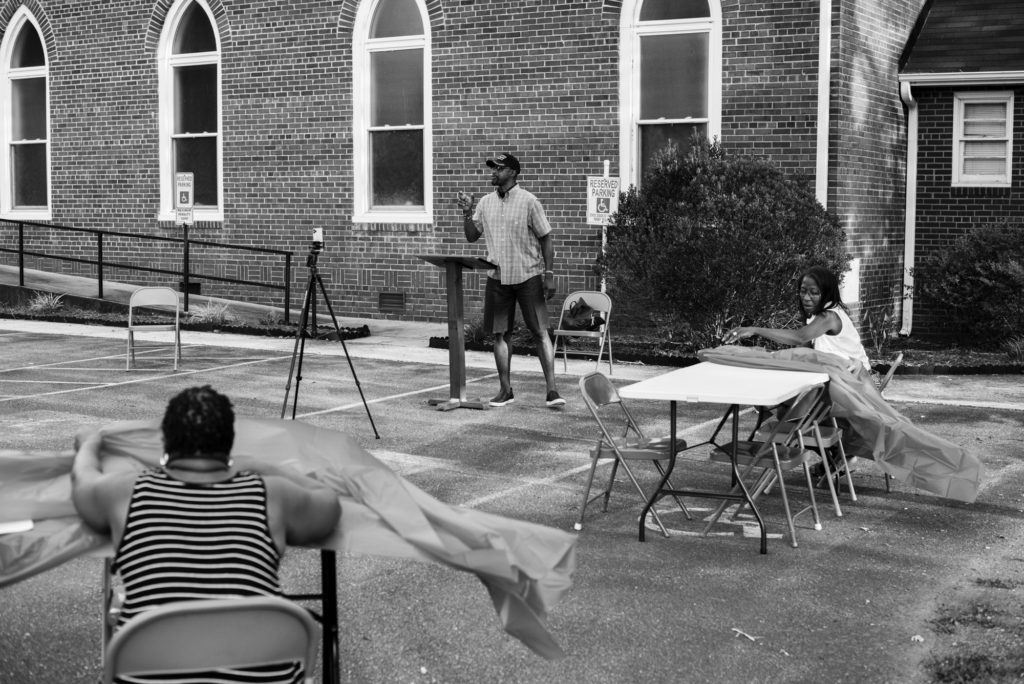
Pastor Ricky Hooker leads a Wednesday evening bible study at Parrish Chapel Church on July 15, 2020 in Graham, United States. (Pete Kiehart)
A federal judge ruled in the plaintiffs’ favor. The Governor declined to appeal the ruling, but continued to argue in a statement from a spokesperson that churches posed a unique danger, writing, “We don’t want indoor meetings to become hotspots for the virus and our health experts continue to warn that large groups sitting together inside for long periods of time are much more likely to cause the spread of COVID-19. While our office disagrees with the decision, we will not appeal, but instead urge houses of worship and their leaders to voluntarily follow public health guidance to keep their members safe.”
This warning has not been universally heeded; in October, a Charlotte-area church held a week-long convocation that hosted up to 1,000 people with few precautions or requirements for participants to wear masks. So far, public health officials have identified at least 213 cases and 12 deaths from the event, and they continue to make efforts to reach nearly 300 close contacts of the infected.
***
Despite the defiance exhibited by some churches, other congregations have found creative solutions to continue their worship, as well as silver linings amidst the worst global health crisis in a century. Tiny Calvander Church, which met at an elementary school prior to the pandemic, began holding services in a parking lot on a corner of the pastor’s farm, where goats sometimes outnumber congregants.
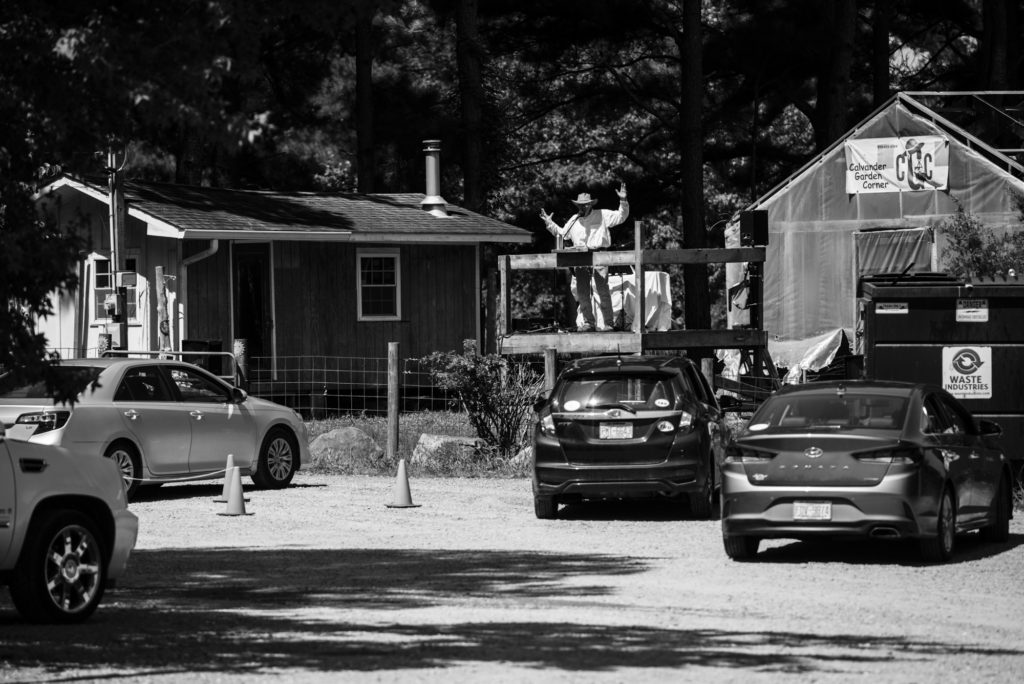
Pastor Kelly Blackwood leads a Sunday morning service at Calvander Church’s temporary location on a corner of the pastor’s farm on July on 12, 2020 in Chapel Hill, North Carolina. (Photo: Pete Kiehart)
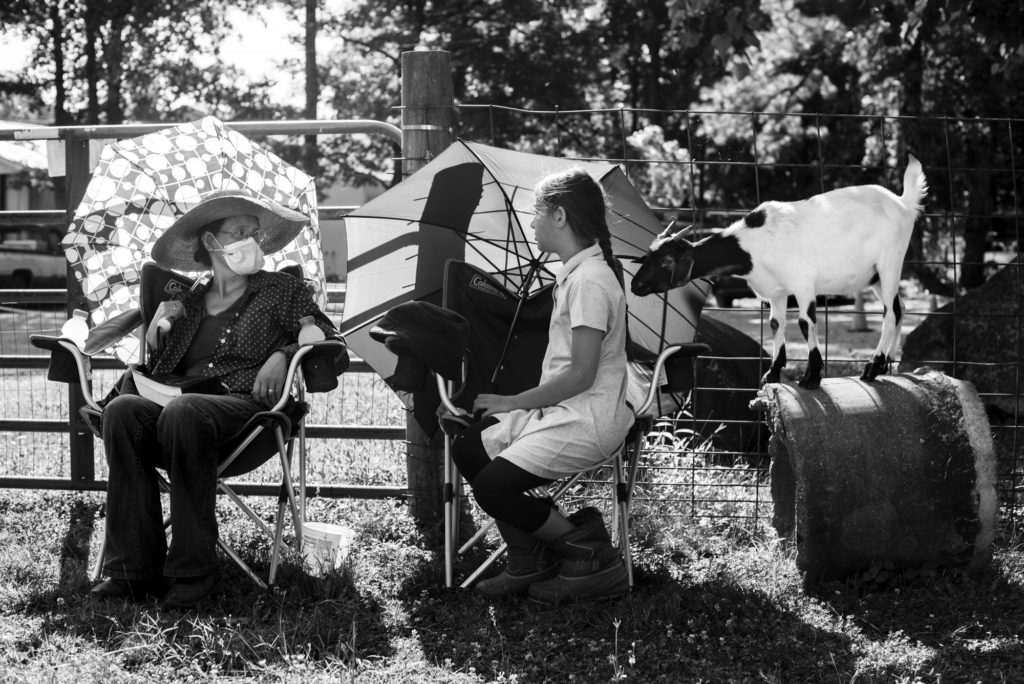
Mayling Blackwood, wife of pastor Kelly Blackwood, and their daughter, Ruby, 9, take part in a Sunday morning service at Calvander Church’s temporary location on a corner of the pastor’s farm on July on 12, 2020 in Chapel Hill, North Carolina. Curious goats, like the one at right, often wander into the service. (Photo: Pete Kiehart)
Further into the countryside is Antioch Baptist Church, which has existed on White Cross Road since 1830. The current incarnation, a stately brick building that dates to 1974, features a colonnade and delicate stained-glass windows. Despite the hardships imposed by the virus on the church’s aging congregation, the crisis has not been without an upside. Antioch has seen a spurt of modernization — to accommodate its livestream, produced from an audiovisual suite in the choir loft, they’ve upgraded their internet and purchased a new camera. “Kinda like the Russians gettin’ Sputnik up — got the United States to get a man on the moon,” quips church member Dallas Myatt.
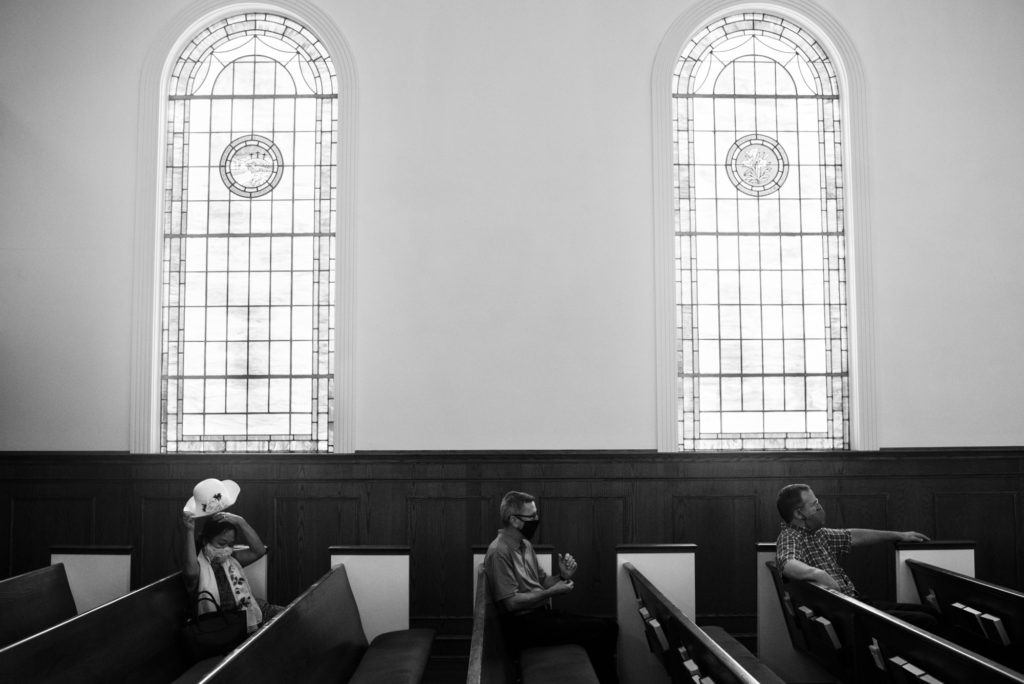
Parishioners gather for a Sunday morning service by Pastor David Atwater at Antioch Baptist Church on August 2, 2020 in Chapel Hill, North Carolina. (Photo: Pete Kiehart)
In nearby Durham, congregants at Holy Infant Catholic Church sign up for services via an online registration system with a strict cap on attendance. Tape has been used to close every other pew and form arrows on the floor, creating a labyrinthine traffic flow for the faithful. A “health ministry” has been established to coordinate taking temperatures and quizzing congregants about recent symptoms. Elizabeth Fixler, a Holy Infant attendee, calls the need for church services “paramount” during this time. “Being close, being a part of worship — all the emptiness of not being with people, all that is brought together and is so deeply affirmed by going to mass and receiving the sacrament.” Communion is given by Pastor Robert Rutledge, who carefully sanitizes his hands before beginning the ceremony and, upon accidentally brushing hands with a church member, pauses to painstakingly repeat the process. As the mass comes to a close, the attendees read from a typed sheet entitled “COVID-19: A Prayer of Solidarity”:
For all who have contracted coronavirus,
we pray for care and healing
For those who are particularly vulnerable,
we pray for safety and protection.
For all who experience fear or anxiety,
we pray for peace of mind and spirit.
For affected families who are facing difficult decisions
between food on the table or public safety,
we pray for policies that recognize their plight.
For those who do not have adequate health insurance,
we pray that no family will face financial burdens alone.
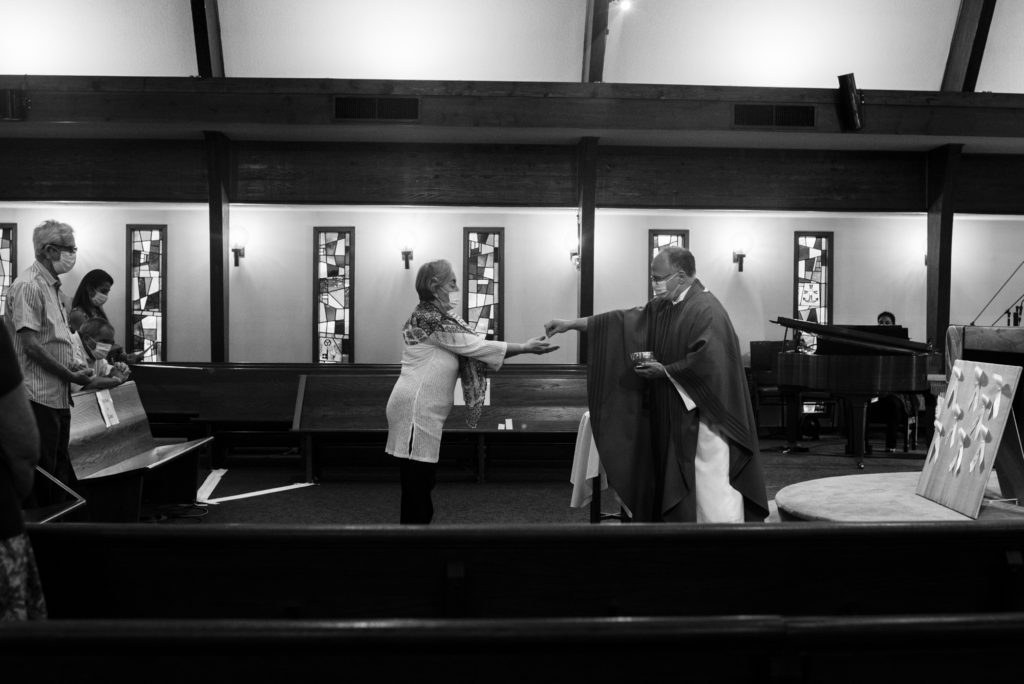
Parishioners receive communion during a Saturday evening mass by Father Robert Rutledge at Church of the Holy Infant on August 1, 2020 in Durham, North Carolina. (Photo: Pete Kiehart)
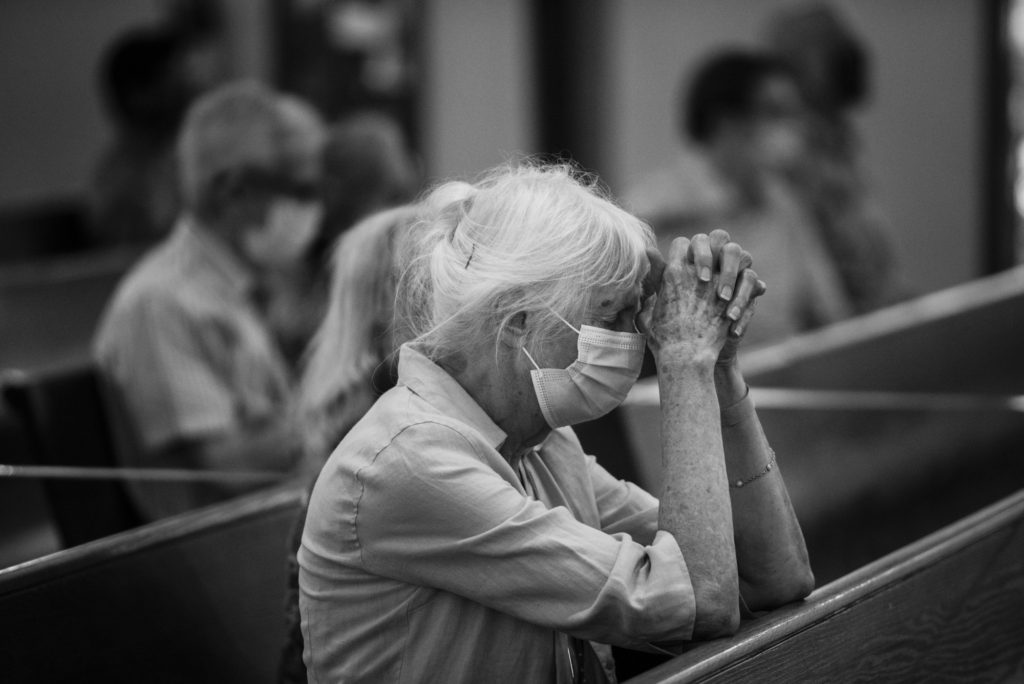
Elizabeth Fixler prays during a Saturday evening Catholic Mass at Church of the Holy Infant on August 1, 2020 in Durham, North Carolina. (Photo: Pete Kiehart)
Over a hundred years ago, as the world grappled with not only a World War, but with an influenza pandemic, pastors used the technology of their times to communicate with congregants after their churches were closed. A letter from the clergy at St. Paul’s Lutheran Church, printed alongside others from a diverse group of spiritual leaders in the October 13, 1918, edition of the Los Angeles Times, suggested an appropriate prayer: “I pray that God, who is our refuge and strength, a very present help in trouble may be with you, and keep you from the snare of the fowler and from the noisome pestilence.”
The same clergy struck a hopeful chord while referencing the city-mandated closures: “While this drastic order will impede the progress of our work, it need not interfere with the spiritual life of the church.”
Pete Kiehart is a freelance photojournalist normally based in Paris, but presently covering current events, namely the pandemic and election, in his home state of North Carolina. More of his work, including projects on topics as disparate as international sports and the European refugee crisis, can be seen at www.petekiehart.com.
***
Published with support from the Henry R. Luce Initiative on Religion in International Affairs.